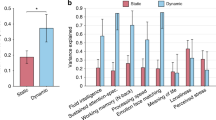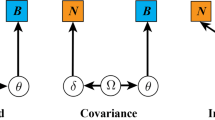Abstract
We consider quantitative measures of behavioral and neuronal dynamics as a means of characterizing phenotypes. Such measures are important from a scientific perspective; because understanding brain function is contingent on understanding the link between the dynamics of the nervous system and behavioral dynamics. They are also important from a biomedical perspective because they provide a contrast to purely psychological characterizations of phenotype or characterizations via static brain images or maps, and are a potential means for differential diagnoses of neuropsychiatric illnesses. After a brief presentation of background work and some current advances, we suggest that more attention needs to be paid to dynamic characterizations of phenotypes. We will discuss some of the relevant time series analysis tools.
Similar content being viewed by others
References
Adey, W. R., Walter, D. O., and Hendrix, C. E. (1961) Computer techniques in correlation and spectral analyses of cerebral slow waves during discriminative behavior. Exp. Neurol. 3, 501–524.
Babiloni, C., Miniussi, C., Moretti, D. V., et al. (2004) Cortical networks generating movement-related EEG rhythms in Alzheimer's disease: an EEG coherence study. Behav. Neurosci. 118, 698–706.
Beer, C. G. (1980) Perspectives on animal behavior comparisons. In: Comparative Methods in Psychology, Bornstein, M. H. (ed.) L. Erlbaum Associates, Hillsdale, NJ.
Brazier, M. A. and Casby, J. U. (1952) Cross-correlation and autocorrelation studies of electroencephalographic potentials. Electroencephalogr. Clin. Neurophysiol. Suppl. 4, 201–211.
Brown, E. N., Kass, R. E., and Mitra, P. P. (2004) Multiple neural spike train data analysis: state-of-the-art and future challenges. Nat. Neurosci. 7, 456–461.
Coutin-Churchman, P., Anez, Y., Uzcategui, M., et al. (2003) Quantitative spectral analysis of EEG in psychiatry revisited: drawing signs out of numbers in a clinical setting. Clin. Neurophysiol. 114, 2294–2306.
Drai, D. and Golani, I. (2001) SEE: a tool for the visualization and analysis of rodent exploratory behavior. Neurosci. Biobehav. Rev. 25, 409–426.
Fries, P., Schroder, J. H., Roelfsema, P. R., Singer, W., and Engel, A. K. (2002) Oscillatory neuronal synchronization in primary visual cortex as a correlate of stimulus selection. J. Neurosci. 22, 3739–3754.
Gallistel, C. R. (1980) The Organization of Action: A New Synthesis. L. Erlbaum Associates, Distributed by Halsted Press, Hillsdale, NJ, New York.
Golani, I., Kafkafi, N., and Drai, D. (1999) Phenotyping stereotypic behaviour: collective variables, range of variation and predictability. Appl. Anim. Behav. Sci. 65, 191–220.
Jarvis, M. R. and Mitra, P. P. (2001) Sampling properties of the spectrum and coherency of sequences of action potentials. Neural Comput. 13, 717–749.
Jones, K. A., Porjesz, B., Almasy, L., et al. (2004) Linkage and linkage disequilibrium of evoked EEG oscillations with CHRM2 receptor gene polymorphisms: implications for human brain dynamics and cognition. Int. J. Psychophysiol. 53, 75–90.
Llinas, R. R., Ribary, U., Jeanmonod, D., Kronberg, E., and Mitra, P. P. (1999) Thalamocortical dysrhythmia: a neurological and neuropsychiatric syndrome characterized by magnetoencephalography. Proc. Natl. Acad. Sci. USA 96, 15,222–15,227.
Percival, D. B. and Walden, A. T. (1993) Spectral Analysis For Physical Applications: Multitaper and Conventional Univeriate Techniques. Cambridge University Press. Cambridge; New York, NY.
Pesaran, B., Pezaris, J. S., Sahani, M., Mitra, P. P., and Andersen, R. A. (2002) Temporal structure in neuronal activity during working memory in macaque parietal cortex. Nat. Neurosci. 5, 805–811.
Porjesz, B., Almasy, L., Edenberg, H. J., et al. (2002) Linkage disequilibrium between the beta frequency of the human EEG and a GABAA receptor gene locus. Proc. Natl. Acad. Sci. USA 99, 3729–3733.
Skinner, B. F. (1991) The Behavior of Organisms: An Experimental Analysis. Copley Pub. Group, Acton, MA.
Tchernichovski, O., Mitra, P. P., Lints, T., and Nottebohm, F. (2001) Dynamics of the vocal imitation process: how a zebra finch learns its song. Science 291, 2564–2569.
Tchernichovski, O., Nottebohm, F., Ho, C. E., Pesaran, B., and Mitra, P. P. (2000) A procedure for an automated measurement of song similarity. Anim. Behav. 59, 1167–1176.
Thakor, N. V. and Tong, S. (2004) Advances in quantitative electroencephalogram analysis methods. Ann. Rev. Biomed. Eng. 6, 453.
Thomson, D. J. (1982) Spectrum Estimation and Harmonic-Analysis. Proc. IEEE 70, 1055–1096.
Thomson, D. J. and Chave, A. D. (1991) Jackknifed Error Estimates for Spectra, Coherences, and Transfer Functions. In: Advances in Spectrum Estimation. Haykin, S. (ed.) Prentice-Hall, Englewood Cliffs, NJ, pp. 58–113.
Tinbergen, N. (1989) The Study of Instinct. Oxford University Press, Oxford.
Author information
Authors and Affiliations
Corresponding author
Rights and permissions
About this article
Cite this article
Bokil, H., Tchernichovsky, O. & Mitra, P.P. Dynamic phenotypes. Neuroinform 4, 119–128 (2006). https://doi.org/10.1385/NI:4:1:119
Issue Date:
DOI: https://doi.org/10.1385/NI:4:1:119




